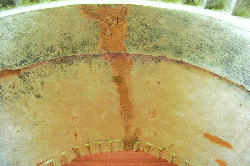Archives
Seismic survey threatens historic Assam monument
to send a team of experts to verify the impact of the cracks.
The expert team will include retired head of the history department of Gauhati University, Jogendra Nath Phukan, Director of Assam Archaeological Department, Hemendranath Dutta, Assistant Superintending Engineer of the Archaeological Survey of India, D. Roy and Executive Engineer of PWD (buildings) Alokesh Sarma.
Talking to Eastern Panorama, Minister for Cultural Affairs, Gautam Bora, said, “We are very concerned and taking all possible measures. The team will assess the damage and find out exactly what has happened and what needs to be done. We are waiting for the report for further action.”
Assam Industry Minister Pradyut Bordoloi talking to media persons and on the floor of the Assembly assured that the Government was ready to stop the seismic survey for oil exploration if it has damaged the ecology and monuments of the State.
The ASI has said it is keeping the monument under close watch after getting complaints that the cracks have  become prominent. “Earlier, we received reports of hairline cracks but those were superficial and could have been the result of ageing,” admitted an ASI official.
become prominent. “Earlier, we received reports of hairline cracks but those were superficial and could have been the result of ageing,” admitted an ASI official.
“We are carrying out inspection of the structure and have also put up devices in the cracks to confirm fears that they are widening with every passing day,” said ASI Superintendent Archaeologist Sanjay K. Manjul. He, however, said the ASI did not have any authority to stop the ONGC from carrying out seismic survey since it was being done outside the notified zone of the monument, which is protected under provisions of the Ancient Monuments and Archaeological Sites and Remains Act, 1952 and Rules, 1959.
Organisations like All Assam Students’ Union (AASU), Asom Jatiyadabadi Yuva Chatra Parishad (AJYCP) and even the ULFA have fired on all cylinders on OIL for the seismic survey and have called for an immediate halt saying it had damaged the river bed of Brahmaputra as well as the historical monuments of the State.
The ONGC survey is being carried out 2.5 km from the monument. It is alleged that the oil major has been carrying out the explosions far above the permissible 60 feet limit for which the overground vibrations are very intense, leading to damages in residential buildings and other structures, including the Rang Ghar.
In a seismic survey, controlled explosions are carried out underground, usually below 60 feet, and sensors placed over ground pick up the vibrations. Under the Ancient Monuments and Archaeological Sites and Remains Act, 1952, and Rules, 1959, any activity within 300 metres of an ASI monument is prohibited. Facing the wrath of the AASU, AJYCP, ULFA and local media, ONGC Deputy General Manager (Public Relations) Dilip Das told reporters that the company has taken care and precaution to ensure that there was no damage whatsoever to any monument in and around Sivasagar where the seismic survey is being carried out.
Facing the wrath of the AASU, AJYCP, ULFA and local media, ONGC Deputy General Manager (Public Relations) Dilip Das told reporters that the company has taken care and precaution to ensure that there was no damage whatsoever to any monument in and around Sivasagar where the seismic survey is being carried out.
Das also informed that a grid plan is being developed to create safe zones around heritage sites and historic monuments in the survey area.
With opposition to the seismic survey gaining momentum, OIL and ONGC are worried that it will severely hamper the upcoming Rs. 6,000 crore Gas Cracker project expected to be completed by 2011, and which is supposed to generate 700 jobs and 5000 indirect employment through downstream industries, if exploration of new oil fields is not carried out. OIL has been on the look out for new oil fields and has identified the Brahmaputra river basin as a suitable area for hydrocarbon reserve.

